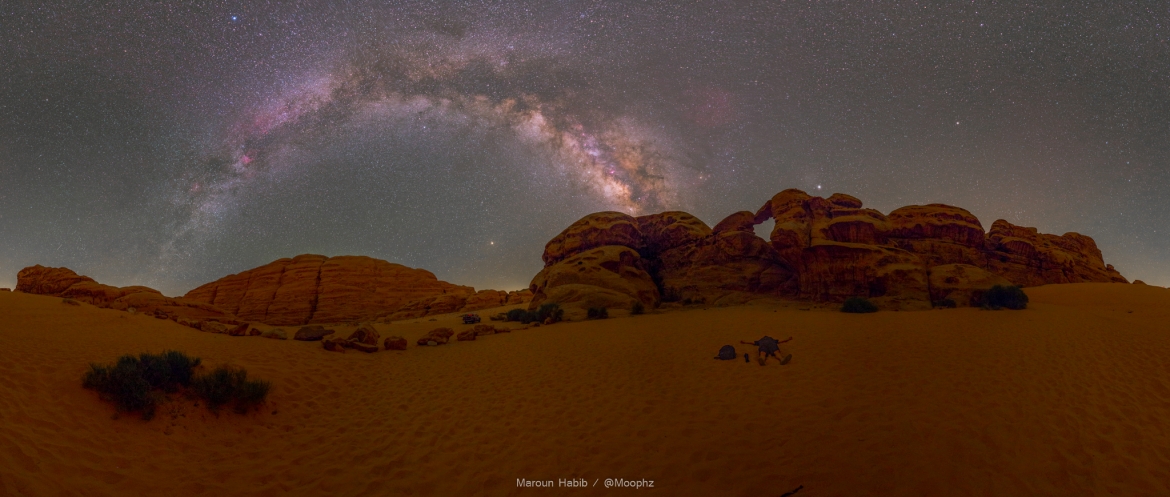The next dark-sky destination is every nightscaper's daydream, and while many go-to locations have been standardized for this matter, breaking out from comfort zones of the well-known ones enables new experiences as an astro-traveler versus an astro-tourist.
I have been on a quest of exploring the dark skies of the Arab World and the Middle East. It goes without saying that Iran, Morocco, Algeria and Oman are still on the top of my bucket list. This article will emphasize over the ones that I have recently visited: Egypt and Jordan. Both locations are a great refuge to practice your hobby.
But why deserts?
There is a causal correlation between Population and Artificial Light at Night (ALAN), deserts are relatively less populated and make the most prestine accessible skies on the planet.
Dark to the extent that:
- The Dark Horse silhouette to be clearly distinguishable
- Jupiter to cast a shadow
- you forget how to use your camera
Starting-off with Egypt...
The White Desert in Egypt: Bortle Class 1 - Excellent Dark-sky Site

Sculptured by centuries of erosions and sandstorms, The White Desert is filled with unique Calcium rock formations, it feels like a natural museum of white Statues. Located in the Sahara (The largest hot desert in the world), this desert is a UNESCO world heritage area. At daylight, the landscape is truly white comparing to a yellow-orangish deserts elsewhere.

One can arrive to the White Desert after 5 hours of drive from Cairo airport. When crossing the 'Aqabat Valley', the fortress gate, sand becomes thicker and dunes erect higher, requiring off-road expertise.
After an hour of sand-dunes-diving, camping on location becomes the smart thing to do rather than returning back to the hotel ("You Shall Not Shower") - in other words, there is no need to book an hotel if you plan to stay for more than 1 night.

Recommendations and Expectations:
- Let a guide lead your trip, it could be a local badouin or a travel agent (astrotourism is a well developped business in Egypt. So far, it is the best I have seen)
- No matter how beautiful some rocks might appear from afar, do not cross to restricted zones, stay with your guide
- Do not expect mobile phone coverage (bummer to live-bloggers)
- If you plan to camp for more than 1 night, make sure that your driver has a 12->220V inverter on board to recharge your batteries
- Do not travel with a telescope, they are not allowed at the borders
- Drones are not allowed either
Wadi Rum in Jordan: Bortle Class 2 - Truly Dark Site
Wadi Rum is also a UNESCO world heritage protected area. Its name means the 'Valley of the Moon' but it looks much more like Mars. "The Martian" and "Red Planet" were filmed there so there is no room to argue.

One can arrive Wadi Rum after 4 hours of drive from Amman airport reaching stationary camps. Fortunately, those camps range from very basic badouin tents to extremely luxurious lodges, some are equiped with ACs and Sonas. Unfortunately, those camps have been spanning randomly with no light-pollution control, but you can always get-away deeper in the desert. In Wadi Rum, most camps are fully equipped with Electricity and Water, and a daily shower is possible.

Recommendations and Expectations:
- Let a driver from the camp lead the way, locals know it better
- Do not expect mobile phone coverage
- Drones are not allowed at the airport without a permit that is hard to acquire
- Petra is a beautiful destination, but don't expect a picture with a milkyway. Milkyway shots with Petra are either Impossible, Fake or Illegal:
- Impossible due to the heavy light pollution originating from the surrounding City
- Fake because the temple is high enough to hide the milkyway core
- Illegal because visitors are not allowed at night
I hope this mini-guide helps you plan your next astro-trip, and if you ever decide on any of those destinations, ping me on Instagram (@moophz), I dont' claim to know everything but I will do my best to put you in contact with the right people.
To be continuted ...




Leave a comment!